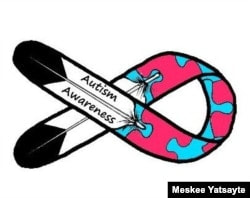Native American Heritage (Autism) Awareness Month
with < My Thoughts > by Sara Luker
Hilleary (2020) – “She didn’t walk until she was 18 months old,” said Native American Korryl High Bear. “Then as she started getting older, she didn’t talk. She was so sensitive to sounds and emotions.” High Bear turned to the Cheyenne River Sioux Tribe Birth to Five Program, in Eagle Butte. “They gave my daughter therapy three times a week. After a year, they sent us to the University of South Dakota, about 6 hours away, for a two-day appointment. The program paid for mileage and lodging.”
Shoemaker, the program director, explained that the Bureau of Indian Education is an ‘arm’ of the Interior Department’s Bureau of Indian Affairs, which provides the program funds. Cautioning that the tribal leaders have discretion on how those funds are used. Continuing that the reservation is big and there are lots of kids with autism that they don’t know about.
Scott (2020) says, “In Navajo, there’s no word for ‘autism’ or ‘disability’. A lot of the elders didn’t understand what we were talking about. They didn’t necessarily see the signs of autism as something to be concerned about. Much of this is due to a lack of awareness,” said this Western Washington University autism expert. For several years, he worked with the University of New Mexico’s Center for Development and Disability, evaluating children on several Native reservations.
IHS Staff Writer (2020) shares that parents and teachers may confuse autism with other conditions; or, chalk up behaviors to disobedience. And, even when Indian children are finally diagnosed with autism, they don’t always get the help they are entitled to receive.
< My Thoughts > “…chalk up behaviors to disobedience.”
Outsiders only see a ‘bad kid’ or ‘bad parenting’, or both. But in the case of a child with autism, the behavior is not him/her giving you a bad time; they are having a bad time.
Just so you know, help is available to Native Americans through the mission of the Indian Health Service (IHS) TeleBehavioral Health Center of Excellence (TBHCE) Indian Children’s Program is to equip healthcare providers working in the Indian Health Service (IHS), Tribal, and Urban Indian Health System with the training and education needed to provide excellent care for American Indian/Alaska Native youth.
It utilizes tele-education, otherwise known as distance learning, to deliver training, education, and virtual consultation services to IHS, Tribal, and Urban Indian Health system (I/T/U) healthcare providers. Providing the following training, education, and consultation on the following topics related to American Indian/Alaska Native youth –
- Autism Spectrum Disorder (ASD)
- Fetal Alcohol Spectrum Disorder (FASD)
- Attention Deficit/Hyperactivity Disorder (ADHD)
- Communication Disorders
- Intellectual Disabilities
- Learning Disorders
- Motor Disorders
- Traumatic Brain Injury (TBI)
The TBHCE Indian Children's Program provides –
- Training: Allows I/T/U providers to access upcoming webinars, past webinars, and on-demand trainings related to ICP topics.
- Provider Consultation Clinic: Allows I/T/U providers to seek expert assistance and clinical guidance from healthcare professionals who specialize in ASD, FASD, and Neurodevelopmental Disorders.
They invite you to feel free to visit the TBHCE website to see the current training opportunities: https://www.ihs.gov/teleeducation/. Studies show that the sooner a child with autism gets services, the greater the chance for learning.
References:
Hilleary, C. (2020). Helping Native American Children with Autism Poses Challenges for Schools; Retrieved online from – https://www.ihs.gov/icp/
IHS Staff Writer (2020). Autism & the Indian Health Service; Retrieved online from – https://www.ihs.gov/icp/
Scott, F. (2020). Helping Native American Children with Autism; Retrieved online from –https://www.voanews.com/a/usa_helping-native-american-children-autism-poses-challenges-schools/6184254.html

 RSS Feed
RSS Feed